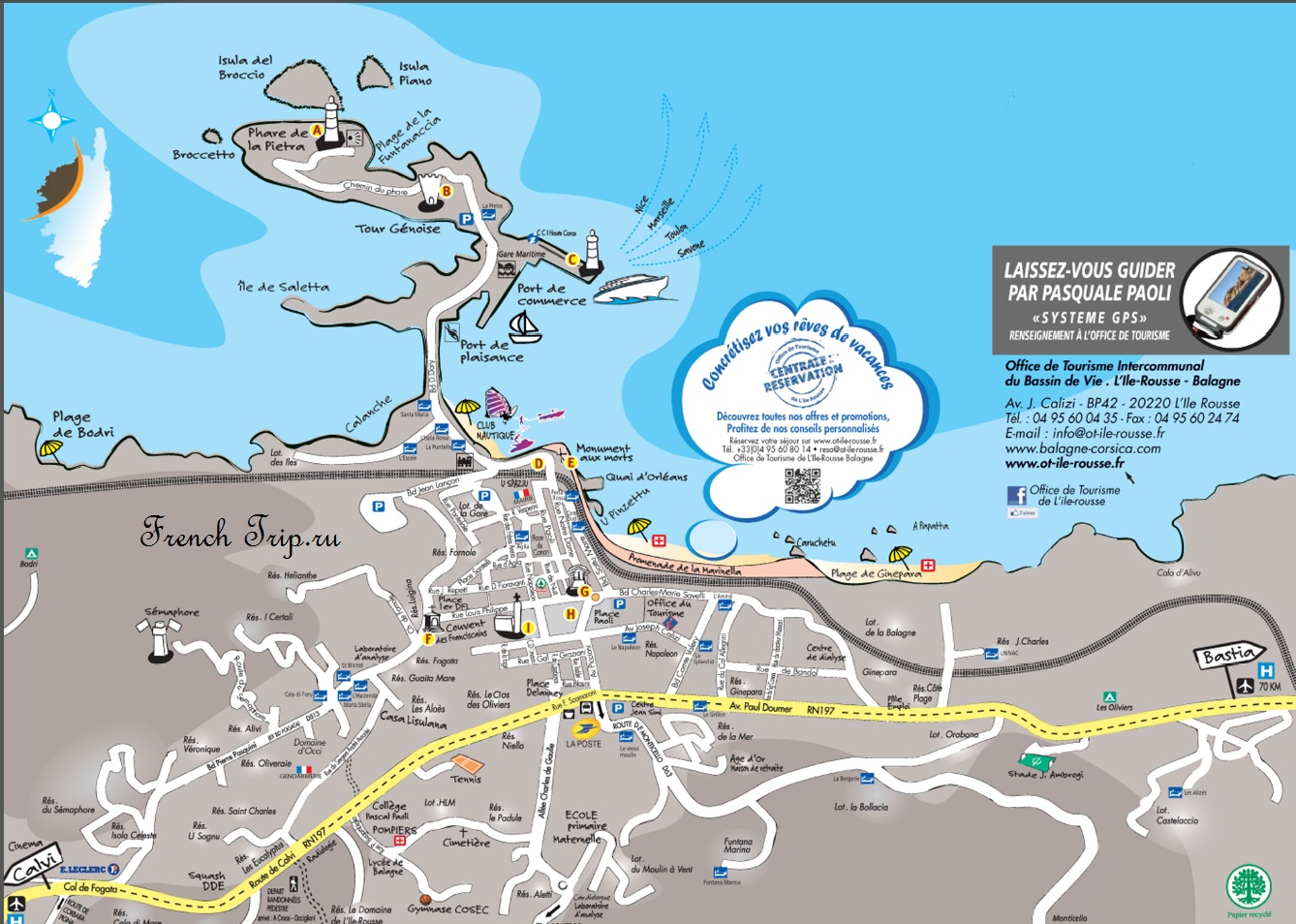L’Île-Rousse
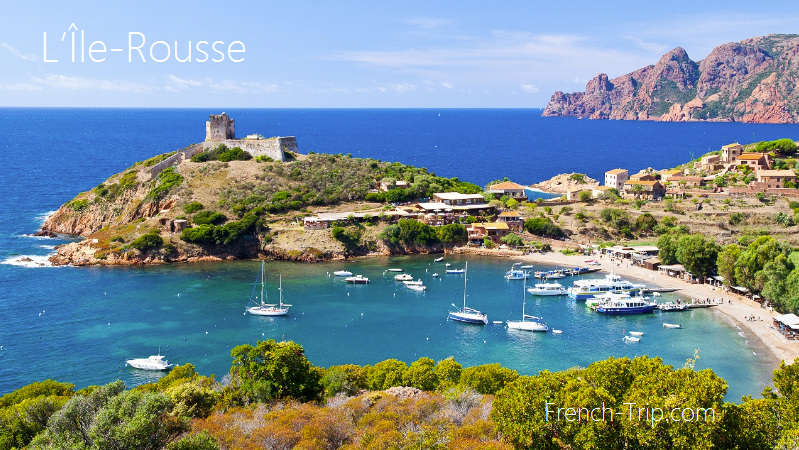
L’Île-Rousse is a small Corsican town with a picturesque rocky port, on which rises an ancient Genoese tower, the symbol of the city. L’Île-Rousse is located in the Balagne region — one of the most popular resort areas of Corsica. The town is considered one of the warmest places on the island: a small mountain closes the bay from the north, and red cliffs sparkling at sunset separate the beach from the sea, and silky white sand makes L’Île-Rousse beach one of the best in Corsica. And regular ferry services connect the city with the continental Marseille, Toulon, Savona and Nice.
Born out of Corsicans’ attempts to wrest control from the Genoese, who had long held the city, L’Île-Rouss came under French rule. But Corsican nationalism still makes itself felt today: locals don’t usually call the town by its French name, but rather by the Corsican name “Isula Rossa” or simply “L’Isula“.
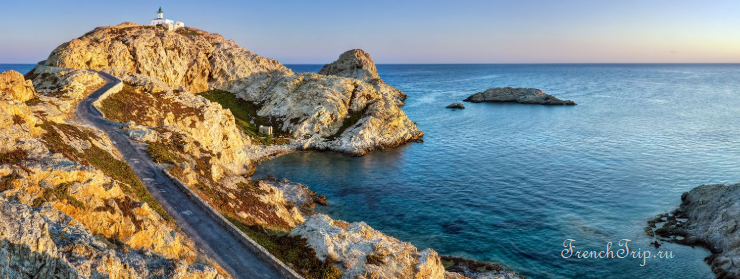
Weather in L’Île-Rousse
L’Île-Rousse travel guide
L’Île-Rousse is a charming seaside town in northwest Corsica, known for its stunning beaches with white sand and crystal-clear waters. Founded by Corsican hero Pascal Paoli in the 18th century, the town boasts a picturesque old town with narrow streets, a lively market, and beautiful views of the red rocky islets that give it its name (“Red Island”). It’s an ideal destination for those seeking relaxation, scenic coastal walks, and a taste of Corsican history and culture. Its central location also makes it a great base for exploring the nearby Balagne region.
Office de Tourisme Intercommunal de L’Ile-Rousse Balagne
- Avenue Calizi – BP 42, 20220 L’Ile-Rousse
- Closed January 1, May 1, November 1, November 11 and December 25.
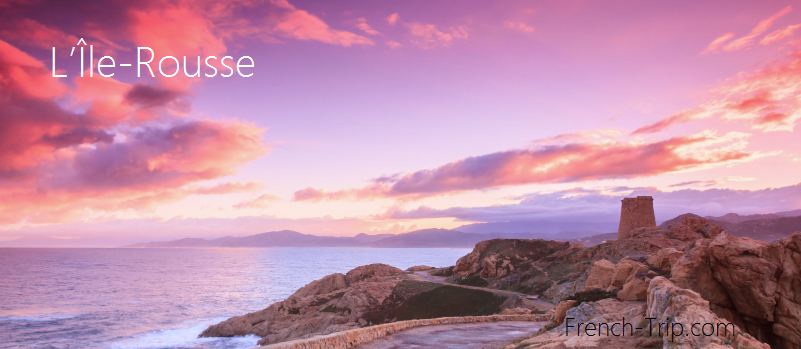
Getting to L’Île-Rousse
To reach L’Île-Rousse in Corsica, you can travel by train or bus. The Calvi-Ile-Rousse train shuttle operates year-round with varying schedules: five daily trains from November to March, five to six trains from April to October, and six trains daily in July and August. Alternatively, Balanina buses offer free rides until September 2024, with daily lines connecting nearby towns and weekly lines to more distant villages. For parking, free options are available in the winter, while parking becomes paid during the high season, with a subscription system for municipal lots.
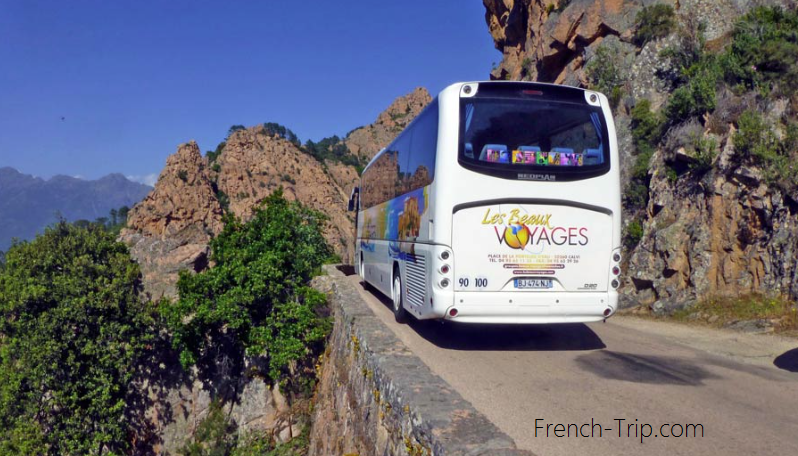
History of L’Île-Rousse
The town was founded in 1758 by Pascal Paoli with the aim of creating a port that would not be in the rivers of the Genoese, like Calvi, for example. Since Italian was the administrative language until 1848, the town was originally called Isola Rossa (Red Island – for the ochre color of the rocks that form the natural port). Together with Saint-Florent, the town is one of two in the department with a French name, all the other towns and villages retained their Italian names.

L’Île-Rousse in 1838
The area has been inhabited since ancient times (3,000 to 5,000 BC). Around 1,000 BC, it was a thriving town called Agilla. Destroyed by the Phoenicians, Agilla came under Roman rule under the name Rubico Rocega (Red Rock) until the 4th century. Being so close to the sea, the town was repeatedly attacked by pirates and other potential enemies, and as a result, for several centuries it was uninhabited, except for fishermen and farmers who lived off the sea and the land around the villages of Santa Reparata and Monticello.
In the 17th century, traders from Santa Reparata set up shops here to trade with the coastal villages of Balagne, Nebbio, and to the west of Cap Corse. Around 1759, Pasquale Paoli, who was a frequent visitor to Balagne, decided to create a port in Corsica to the northwest, to interrupt the sea route between Genoa and Calvi. He managed to convince the government of Balagne, located in Algajola, of the need to create a fortress to protect the port (Scalu) on December 10, 1765. Thus, today’s L’Île-Rousse was born.

Attractions
Church of L’Immaculée Conception de Marie
The Church of the Immaculate Conception of the Virgin Mary is located in the city center overlooking Place Paoli. It was built in 1892, but was badly damaged by fire in 1914. The church was restored only in the 1930s.
The church contains two paintings, probably from the Fesch collection (Fesch Museum in Ajaccio), classified as a historical monument: “The Temptation of Christ” from the 17th century, and “Saint Jerome” from the 17th century.
Eglise de la Miséricorde
This Church of Mercy is also called the Collegiate Church. It is located to the east of the church of L’Immaculée Conception de Marie. In 2010-11 it was restored.

Phare de la Pietra — Pietra Lighthouse
The lighthouse is also called “L’Île-Rousse Lighthouse“. It was built in the 3rd quarter of the 19th century and is listed as a cultural heritage site in France.
The lighthouse was part of the second island lighting program, which also included the Madonetta lighthouse, the citadel of Ajaccio, the port of Bastia, and the lighthouse of the Lavezzi Islands (near Bonifacio).
Initially, in 1857, a permanent red light was installed here. It was replaced in 1877 by a more powerful white light bulb. Since 1902, it has been flashing three times every 12 seconds. The current lighthouse is powered by solar panels installed on the roof. It operates automatically. Unfortunately, it is not possible to visit the lighthouse, you can only admire it from the outside during a walk to the island of la Pieta.
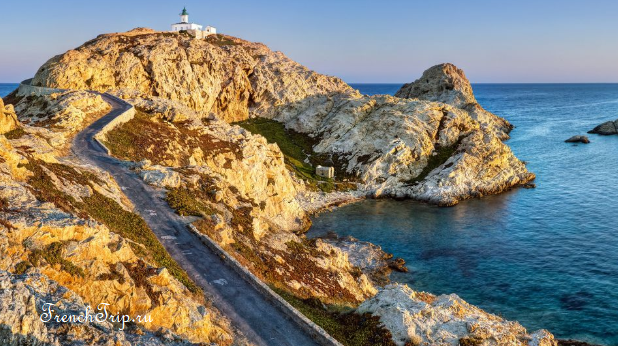
Covered Market
The covered market L’Île-Rousse was built in 1844-46. It was repainted in its original colors in 2011. On January 5, 1993, it was listed as a historical monument of France.
The market is still open today: in the morning you can buy the freshest fruits and vegetables from the Balagne region.

Jardin de l’hôtel Napoleon Bonaparte
The garden of the Hotel Napoleon Bonaparte (Hôtel des Voyageurs) – Place Paoli – is considered a cultural heritage monument.

Tour de L’Île-Rousse
This is the name of the Genoese tower on the islet of île de la Pietra, a rocky archipelago of red porphyry. The tower is well preserved. You can reach it on the way to the La Pietra lighthouse, but you cannot go inside the tower. This tower is the main symbol of the city.
Tour de Scalu
The Scalu Tower, located on the Place de la Mairie, was built in the 17th century and was called the Fabiani Tower. The Fabiani were one of the main families in the town of Santa-Reparata-di-Balagna in the canton of l’Île-Rousse, owners of magazini (warehouses) and botteghe (shops) during the Genoese period, before the construction of the port of Île Rousse by Pascal Paoli. The tower was intended to protect the property of the Fabiani family.
The tower also stored salt, brought from the salt pans of Provence. Salt provided a significant income in the form of a salt tax. It was called “gabelle” and was levied in France until 1790. The term gabelle comes from the Latin gabulum (tax). In France, the gabelle was initially applied to taxes on all raw materials, but was gradually limited to the tax on salt.

Gabel
Over time, the gabelle became one of the most hated and unequal taxes in the country. But despite the large number of supporters of reform, the tax was not abolished until 1790. First introduced as a temporary war tax in 1286 during the reign of Philip IV, it became a permanent tax during the reign of Charles V.
Starting in 1342, centralized salt warehouses were established in each province, owned by the state and called Greniers à sel. Each salt producer had to sell all the salt exclusively to the salt warehouses, under pain of confiscation, at a fixed price. The purchased salt was then resold to retailers at a higher price. The difference between the price at which the state bought the salt from the producers and the selling price of the salt to retailers constituted the tax (gabel).
The tower
On April 5, 1731, during the Corsican revolt against Genoa, Tour de Scalu was seized by the Corsicans. Paoli fortified it to protect the Palazzu, the city hall building. However, on May 25, 1769, the French captured the tower. It was confiscated and repurposed as a military supply depot.
On August 2, 1778, a fire broke out in the tower, leading to a massive explosion that devastated part of the area. Father Don Antonio Orticoni, a former military corporal, recorded in his diaries: “Five men and one woman died, not to mention the many wounded.” The tower was subsequently rebuilt, though it was reduced in height by two meters and once again served as a powder magazine.
In 1900, the city authorities purchased the building. During 1943, it was briefly used as a prison to hold suspected collaborators. Later, Tour de Scalu was transformed into a display space for archaeological finds recovered from the surrounding waters.
The nearby barracks, now the city hall, once served as the residence for tax collectors.
Place Paoli
It was created in 1834 and is now the heart of the city.
Bust of Pascal Paoli
 Located in the main square of L’Île-Rousse, the bust represents Pascal Paoli, a key figure in Corsican history. Paoli was a politician and military leader who led the Corsican Republic from 1755 to 1769 and later took part in the Napoleonic Wars.
Located in the main square of L’Île-Rousse, the bust represents Pascal Paoli, a key figure in Corsican history. Paoli was a politician and military leader who led the Corsican Republic from 1755 to 1769 and later took part in the Napoleonic Wars.
In 1739, Paoli and his father, General Giacinto Paoli, were exiled to Naples by the Genoese. Paoli was educated at a military academy there. Returning to Corsica in 1755, he became head of the government and captain general, establishing peace, forming an army, and driving the Genoese to coastal fortresses.
By 1763, Paoli’s forces had captured Caprara Island, forcing Genoa to seek help from France. When negotiations failed, France sent troops to defeat Paoli. After a final loss in 1769, he fled to England, where he lived in exile for 20 years. In 1790, the French National Assembly invited him back, and he became a leader in Corsica once again, but eventually clashed with France. With English support, Paoli temporarily cleared the island of French forces.
However, England’s control over Corsica limited Paoli’s influence, and he returned to England in 1796, where he lived near London, receiving a pension. Paoli died in 1807 and was buried in Westminster Abbey, though his remains were later moved to his home village of Morosaglia. Today, the University of Corsica is named in his honor.
Monument aux morts de Volti
This is a monument in honor of those who died during two world wars: 1914-1918 and 1939-1945. The author of the sculpture was Antoniucci Voltigero, therefore the monument is often called Volti. The monument is located opposite the city hall of Ile-Rousse.
Windmill
The mill was built in 1803 to grind wheat, reflecting the region’s agricultural activity in the past.

L’Île-Rousse walking tour
Eating in L’Île-Rousse
In L’Île-Rousse, traditional Corsican cuisine is characterized by simple, hearty dishes that make the most of local ingredients. Specialties include figatellu (smoked pork sausage), civet de sanglier (wild boar stew), and aziminu (Corsican fish soup). Cheeses like brocciu, made from ewe’s milk, are widely used in dishes and desserts. You’ll also find chestnut-based dishes, like pulenta, and desserts such as fiadone (cheesecake) and canistrelli (sweet biscuits). The cuisine often pairs well with the region’s renowned wines.
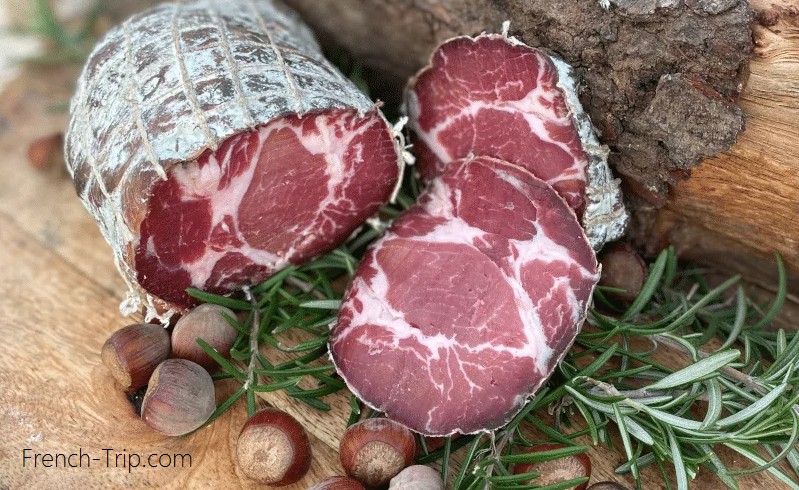
Coppa
Shopping
L’Île-Rousse offers a charming shopping experience, with a mix of local boutiques, markets, and artisan shops. The town’s central market, located at Place Paoli, is ideal for purchasing fresh produce, Corsican cheeses, meats, and other local specialties. Nearby, small shops sell handmade crafts, souvenirs, and regional products such as olive oil, honey, and wines. Visitors can also explore fashion boutiques, jewelry stores, and art galleries scattered around the town.
Tempi Fà
The delicacies at Fred Guistini are 100% guaranteed Corsican – to take home or enjoy on site.
- 3, rue du Général Graziani, 20220 L’Île-Rousse, Tel. 04 95 37 77 08
Map of L’Île-Rousse
Holidays and festivals in Île-Rousse
- 5th February: Santa Agatha, patron saint of Corsican fishermen, mass on the island of Pietra
- 2nd June: Saint Erasmus, patron saint of sailors, mass and procession
- 24th June: Saint John, fire in Place Paoli
- end of August – beginning of September: Ile-Rousse Fair, 5 days of celebration
- 8th December: Feast of the Immaculate Conception (Cuncezzione) Festa di Nazione, mass and procession
L’Île-Rousse on a map of Corsica:
→ Back to Corsica travel guide
Archives
Calendar
| M | T | W | T | F | S | S |
|---|---|---|---|---|---|---|
| 1 | 2 | 3 | 4 | 5 | 6 | 7 |
| 8 | 9 | 10 | 11 | 12 | 13 | 14 |
| 15 | 16 | 17 | 18 | 19 | 20 | 21 |
| 22 | 23 | 24 | 25 | 26 | 27 | 28 |
| 29 | 30 | 31 | ||||
